5. Kim H, Ahn JS, Kim H, Cha YS, Lee J, Kim MH, et al. Sociodemographic and clinical characteristics of old-old suicide attempters compared with young-old and middle-aged attempters. Int J Geriatr Psychiatry. 2018; 33(12):1717–1726. PMID:
30264415.

6. Woo S, Lee SW, Lee K, Seo WS, Lee J, Kim HC, et al. Characteristics of high-intent suicide attempters admitted to emergency departments. J Korean Med Sci. 2018; 33(41):e259. PMID:
30288157.

7. McIntosh JL. Suicide prevention in the elderly (age 65–99). Suicide Life Threat Behav. 1995; 25(1):180–192. PMID:
7631371.
8. Choi JW, Kim TH, Shin J, Han E. Poverty and suicide risk in older adults: a retrospective longitudinal cohort study. Int J Geriatr Psychiatry. 2019; 34(11):1565–1571. PMID:
31276241.

9. Wiktorsson S, Runeson B, Skoog I, Östling S, Waern M. Attempted suicide in the elderly: characteristics of suicide attempters 70 years and older and a general population comparison group. Am J Geriatr Psychiatry. 2010; 18(1):57–67. PMID:
20094019.

10. Kim KH, Jeong KY, Lee JS, Choi HS, Hong HP, Ko YG. The characteristics of elderly patients with suicide attempts: a comparative study with non-elderly patients. Ann Geriatr Med Res. 2016; 20(4):209–220.

11. Fässberg MM, Cheung G, Canetto SS, Erlangsen A, Lapierre S, Lindner R, et al. A systematic review of physical illness, functional disability, and suicidal behaviour among older adults. Aging Ment Health. 2016; 20(2):166–194. PMID:
26381843.

12. Park JI, Yang JC, Han C, Park TW, Chung SK. Suicidal ideation among Korean elderly: risk factors and population attributable fractions. Psychiatry. 2016; 79(3):262–281. PMID:
27880624.

13. Choi M, Kim DH, Lee K, Yi JS. Physical, psychological, and social risk factors affecting suicidal ideation among the elderly. J Korean Neuropsychiatr Assoc. 2015; 54(4):459–467.

15. Lim JY, Lee DH. Characteristics of drugs ingested for suicide attempts in the elderly. J Korean Med Sci. 2018; 33(11):e86. PMID:
29495136.

16. Inagaki M, Kawashima Y, Kawanishi C, Yonemoto N, Sugimoto T, Furuno T, et al. Interventions to prevent repeat suicidal behavior in patients admitted to an emergency department for a suicide attempt: a meta-analysis. J Affect Disord. 2015; 175:66–78. PMID:
25594513.

17. Kim H, Park J, Kweon K, Ahn J. Short- and long-term effects of case management on suicide prevention among individuals with previous suicide attempts: a survival analysis. J Korean Med Sci. 2018; 33(32):e203. PMID:
30079004.

18. Shin HJ, Park GJ, In YN, Kim SC, Kim H, Lee SW. The effects of case management program completion on suicide risk among suicide attempters: a 5-year observational study. Am J Emerg Med. 2019; 37(10):1811–1817. PMID:
30594409.

19. Park GJ, Shin J, Kim SC, Na DS, Lee HJ, Kim H, et al. Protective effect of helmet use on cervical injury in motorcycle crashes: a case-control study. Injury. 2019; 50(3):657–662. PMID:
30765183.

20. Kim YR, Choi KH, Oh Y, Lee HK, Kweon YS, Lee CT, et al. Elderly suicide attempters by self-poisoning in Korea. Int Psychogeriatr. 2011; 23(6):979–985. PMID:
21356160.

21. Pillans PI, Page CB, Ilango S, Kashchuk A, Isbister GK. Self-poisoning by older Australians: a cohort study. Med J Aust. 2017; 206(4):164–169. PMID:
28253466.

22. Ticehurst S, Carter GL, Clover KA, Whyte IM, Raymond J, Fryer J. Elderly patients with deliberate self-poisoning treated in an Australian general hospital. Int Psychogeriatr. 2002; 14(1):97–105. PMID:
12094912.

23. Lee HS, Han J, Kim JH, Kim S, Kim SH, Lee JS, et al. Epidemiologic characteristics of intentional poisoning: emergency department based injury in-depth surveillance during 2011–2015. J Korean Soc Clin Toxicol. 2017; 15(2):131–139.
24. Dong X, Chang ES, Zeng P, Simon MA. Suicide in the global Chinese aging population: a review of risk and protective factors, consequences, and interventions. Aging Dis. 2015; 6(2):121–130. PMID:
25821640.

25. Kim J, Shin SD, Jeong S, Suh GJ, Kwak YH. Effect of prohibiting the use of Paraquat on pesticide-associated mortality. BMC Public Health. 2017; 17(1):858. PMID:
29096617.

26. Cha ES, Chang SS, Gunnell D, Eddleston M, Khang YH, Lee WJ. Impact of paraquat regulation on suicide in South Korea. Int J Epidemiol. 2016; 45(2):470–479. PMID:
26582846.

27. Ko S, Cha ES, Choi Y, Kim J, Kim JH, Lee WJ. The burden of acute pesticide poisoning and pesticide regulation in Korea. J Korean Med Sci. 2018; 33(31):e208. PMID:
30069172.

28. Kim SJ, Chung SP, Gil HW, Choi SC, Kim H, Kang C, et al. The poisoning information database covers a large proportion of real poisoning cases in Korea. J Korean Med Sci. 2016; 31(7):1037–1041. PMID:
27365999.

29. Brooks SE, Burruss SK, Mukherjee K. Suicide in the elderly: a multidisciplinary approach to prevention. Clin Geriatr Med. 2019; 35(1):133–145. PMID:
30390980.
30. Oyama H, Koida J, Sakashita T, Kudo K. Community-based prevention for suicide in elderly by depression screening and follow-up. Community Ment Health J. 2004; 40(3):249–263. PMID:
15259630.

31. Hawton K, Witt KG, Taylor Salisbury TL, Arensman E, Gunnell D, Hazell P, et al. Psychosocial interventions for self-harm in adults. Cochrane Database Syst Rev. 2016; (5):CD012189. PMID:
27168519.

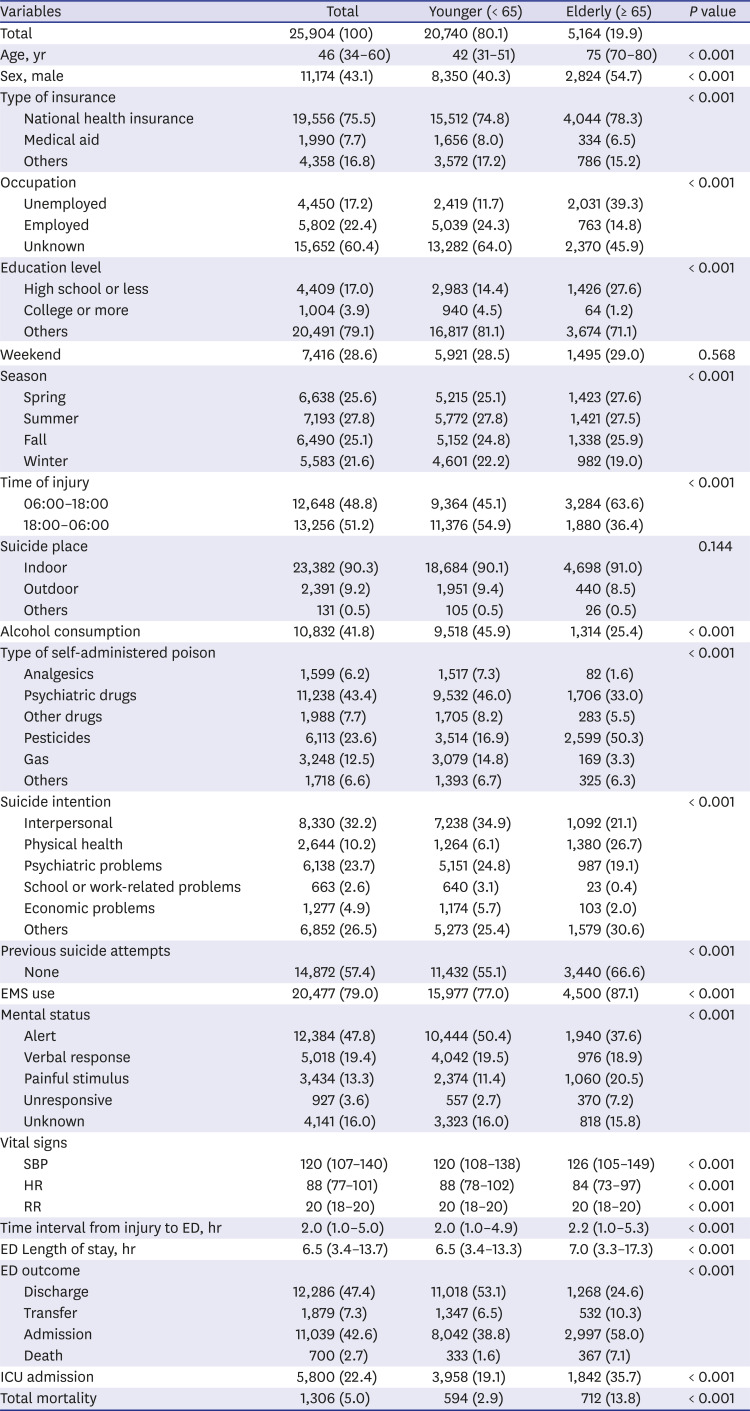
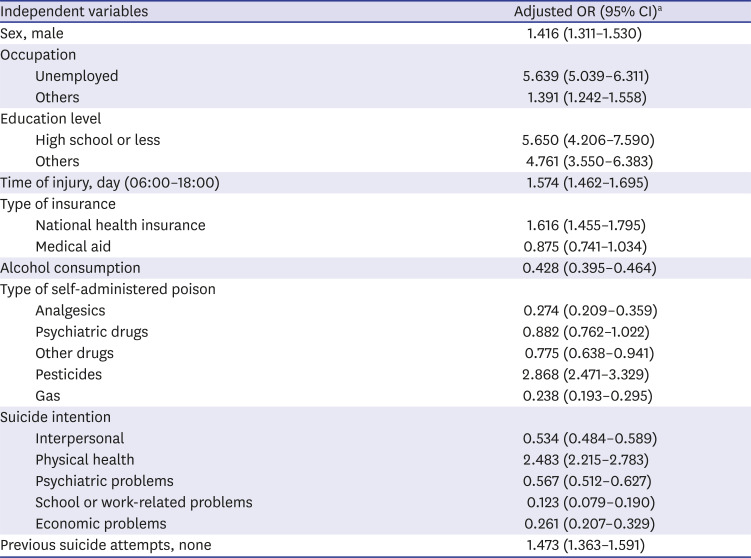




 PDF
PDF Citation
Citation Print
Print



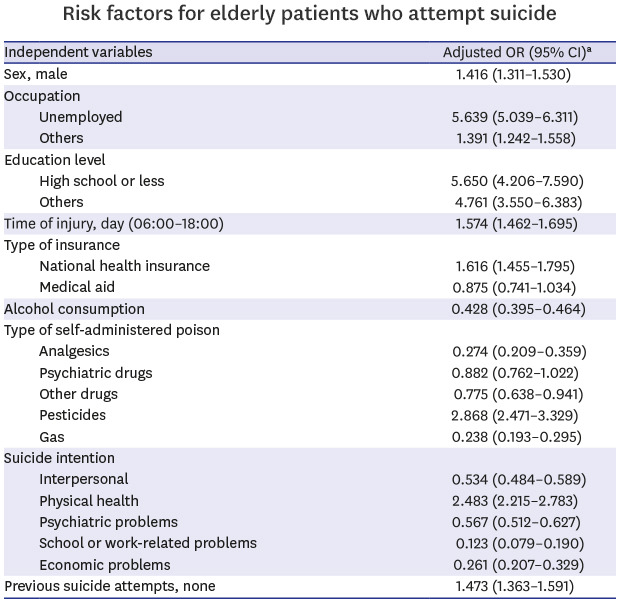
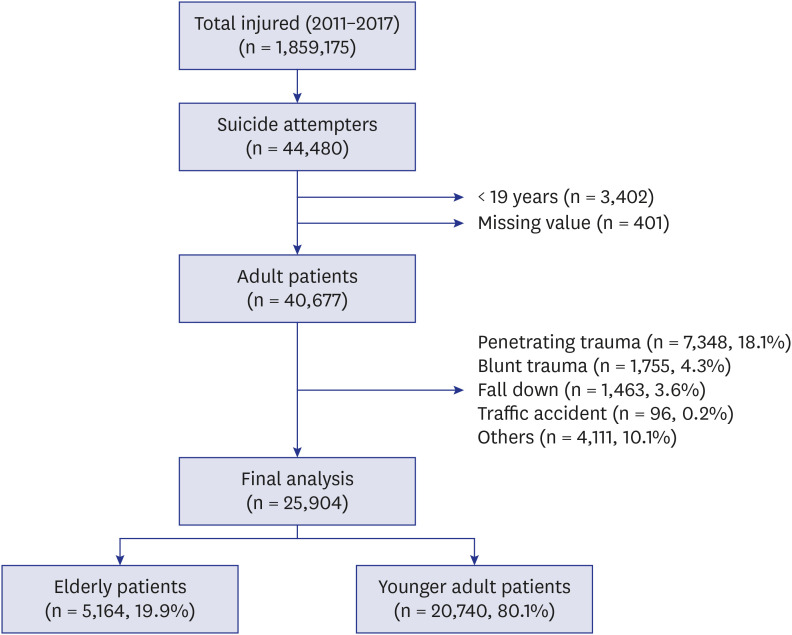
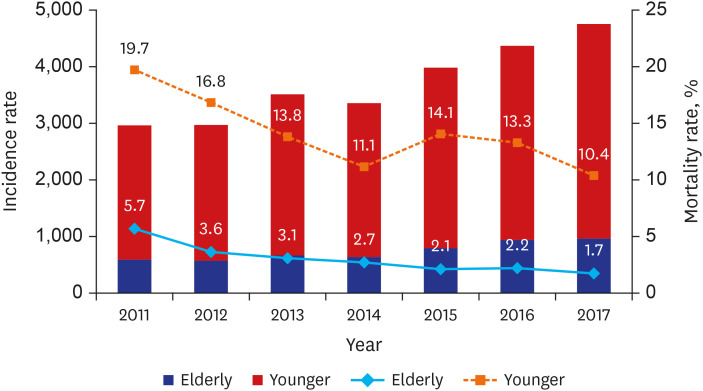
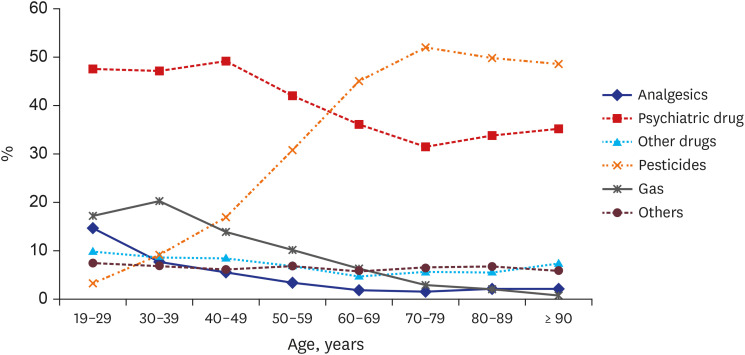
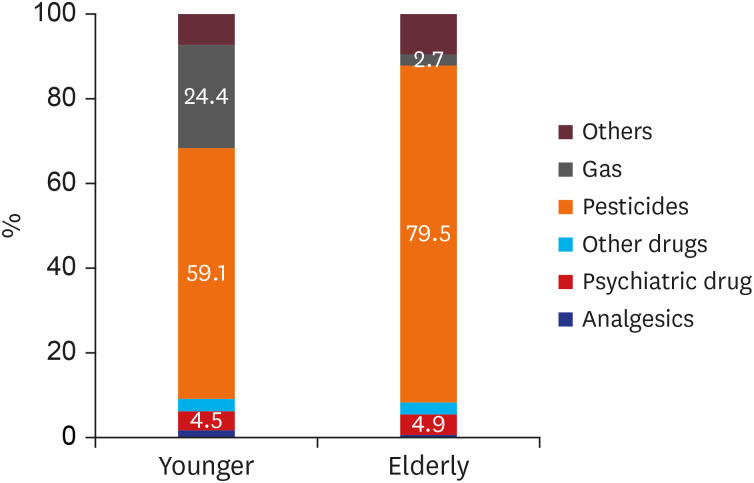
 XML Download
XML Download